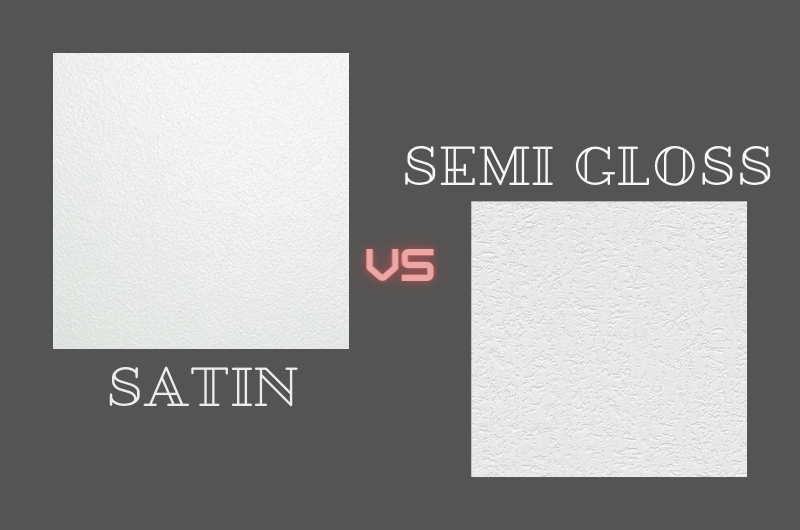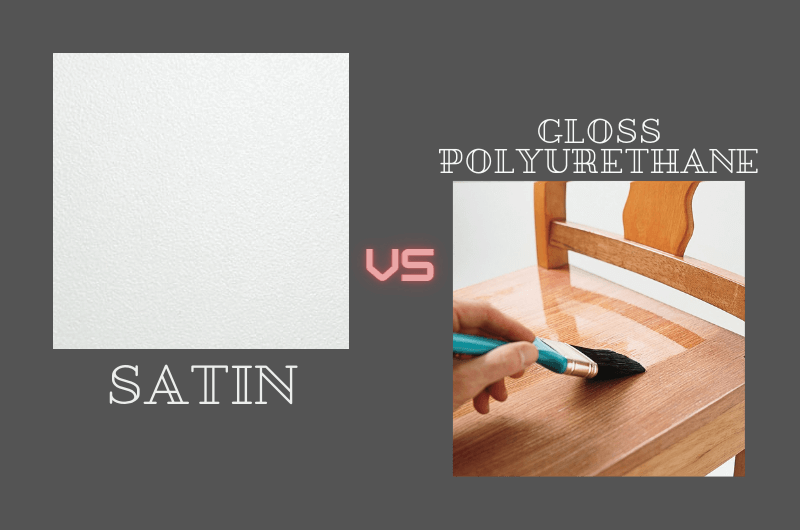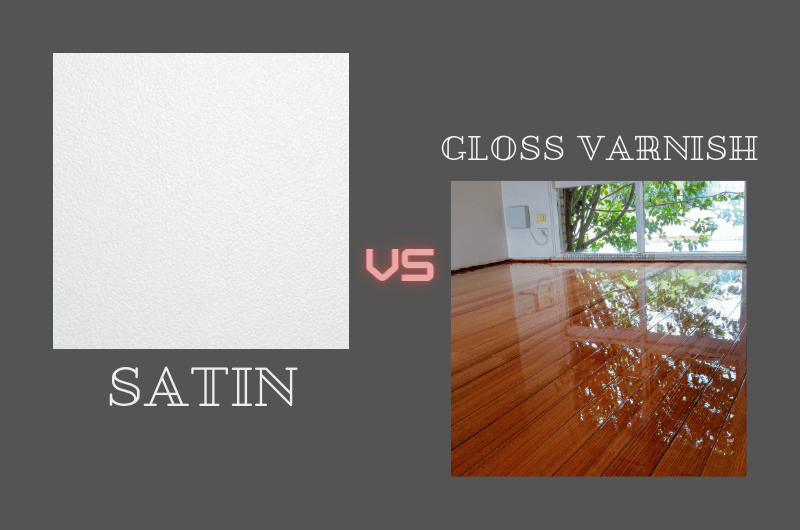Deciding what finish to use when renovating the walls of your home or deciding the final outlook of your office furniture feels exactly like being at a crossroads. Do you use a satin or do you use a gloss finish?
Satin and gloss are both brilliant finishes and that’s why they are widely used. The main difference, however, lies in their sheen. Satin is more matte while gloss is reflective. If you prefer something in-between, there’s the semi-gloss finish, but we’ll get to that later.
Gloss and satin finishes have other differences and understanding the results they give and the results you need will help you make the best choice. When it comes to comparing satin and gloss, here’s all you need to know.
What is a Satin Finish?
A satin finish provides you with a very slight sheen. It isn’t completely matte, as it reflects a bit, but it’s not a reflective surface either. You’d hardly see light reflecting off the finish 8 out of 10 times.
One thing to note is that paint’s sheen is determined by the amount of binder it contains. Less reflective finishes have a lower binder-to-pigment ratio while more reflective finishes have a higher binder to pigment ratio.
Types of Satin Finish Products
For your refinishing or finishing projects, you’ll find products from different brands that provide outstanding satin finishes. Each satin finish product has its specific use, and if used otherwise may not produce the results you desire.
The different types of satin finish products are:
- Satin finish spray paint
- Satin finish sealants
- Satin finish paint
- Satin finish clear coat
- Satin finish furniture wax
- Satin finish varnishes
- Satin finish stains
The Benefits of a Satin Finish
- Exact color: Satin finishes give more exact colors than glossy finishes. They don’t reflect much light which means there’s little or no chance of the lighting altering the outlook of the surface.
- Smooth surface: When you apply a satin finish to a wall or furniture, it gives that smooth look and feel. If you run your fingers across the surface you applied it to, they glide smoothly and don’t stick or run into bumps.
- Long-lasting: Just like the paint, the satin finish is durable. It is resistant to wear and tear more than any other matte finish.
- Covers imperfection: Imperfection-like dents will be less obvious with satin finishes since they don’t reflect light that much. While they don’t cover imperfections completely, they are a better option compared to glossy finishes.
- Easy maintenance: All it takes to clean any surface you use a satin finish on is by using mild cleansers. They clean your surfaces perfectly without leaving any stain or damage behind.
Where can You Use a Satin Finish?
Satin finishes can be used in rooms that are already bright or don’t need too much brightness like bedrooms and living rooms. Since they can be maintained easily, they can also be used in areas where walls are frequently touched like kitchens, hallways, or kids’ bedrooms.
What is a Semi-Gloss Finish?
A semi-gloss finish offers a little more sheen than a satin finish. Semi-gloss finishes are moderately reflective, as they reflect light to a noticeable degree. However, they are not overpowering, even when used to cover large areas.
Types of Semi-Gloss Finish Products
These are the types of semi-gloss finish products you can find on the market:
- Semi-gloss finish spray paint
- Semi-gloss finish sealants
- Semi-gloss finish paint
- Semi-gloss finish clear coat
- Semi-gloss finish furniture wax
- Semi-gloss finish varnishes
- Semi-gloss finish stains
The Benefits of a Semi-Gloss Finish
- Brighter: It is great for brightening up spaces. It can be used to make a small, poorly ventilated room brighter since it moderately reflects light.
- Highly durable: Semi-gloss finishes last for a very long time and can resist hard scrubbing.
- Moisture-resistant: It doesn’t absorb moisture which makes it ideal for humid surfaces like kitchens and bathrooms.
Where can You Use a Semi-Gloss Finish?
Semi-gloss finish is the best paint finish for bathroom walls, kitchen walls, or any other moisture-prone area since it is resistant to moisture. It can also be used for frequently used or touched furniture like kitchen cabinets, bedroom dressers, or bookshelves.
What is a Gloss Finish?
A gloss finish is a shiny finish. It achieves this by reflecting a lot of light and giving surfaces it is used on a gleaming look.
Types of Gloss Finish Products
A lot of painting, finishing, and refinishing products come with a gloss finish. Here are the types of gloss finish products they can come in:
- Gloss finish spray paint
- Gloss finish sealants
- Gloss finish paint
- Gloss finish clear coat
- Gloss finish varnishes
- Gloss finish stains
You would notice they don’t come in furniture wax and that’s because furniture wax doesn’t achieve a high-gloss finish. Although furniture wax can be polished to provide a better quality of sheen, it’s just preferable to use any of the above types.
The Benefits of a Gloss Finish
- Brighten surfaces: Glossy finishes reflect a lot of light which brightens up dark rooms and corners to a noticeable degree.
- Highly durable: Gloss finish doesn’t just look great on a surface; it looks great on any surface for a long time until you decide to change or upgrade it.
- Moisture and stain resistance: Can you imagine moisture on a glossy surface? Exactly, not possible! Same with stains, glossy finishes are resistant to both of them.
- Easy to clean: It is very easy to clean requiring only a damp cloth.
Which Finish (Satin or Gloss) Is More Durable for Car Paint?
When deciding between satin or gloss finish for car paint, consider durability. Satin finish offers a low sheen and is more forgiving of imperfections, but may not be as durable as a gloss finish. However, the cost to paint car hood should also be factored in when making this decision.
What are the differences between satin and gloss finishes and which one is the best for powder coating?
Satin and gloss finishes are two common types of powder coating. Satin offers a smooth, low-gloss appearance, while gloss provides a shiny, reflective finish. The best choice depends on the desired look and level of durability. Both types of powder coating offer excellent protection and can enhance the appearance of the coated surface.
Where can You Use a Gloss Finish?
We have already established that gloss finishes are highly reflective, so you have to be sure of how and where you apply them. They are suitable for high-end or luxurious furniture, you know, like the ones in 5-star hotels.
Satin, Gloss, and Semi-Gloss: How They Compare
Now, that you’ve learned about these paint finishes individually, the next or easiest way of deciding which to go for is to compare them side by side. That would make it easier for you to see the aspects one finish is better than the other, and you can draw overall conclusions yourself based on what you find and the results you desire to produce with any of these paint finishes.
Satin vs. Gloss Paint
Comparing satin and gloss paint side by side, satin paint finish virtually looks matte which appears less shiny than a gloss finish. They complement each other well since they are on opposite ends of the sheen spectrum.
They are both durable and can be applied on almost any wall or surface. Satin, however, gives a truer or bolder color since it doesn’t reflect light as much as gloss. Gloss is mostly suitable for accent walls or pieces where you need the reflection of light to draw focus on décor pieces.
Satin vs. Semi-Gloss Paint

In terms of sheen, satin and semi-gloss paint are quite similar, only semi-gloss is a bit shinier. Semi-gloss doesn’t give true colors like satin; the colors appear to be slightly different since it reflects more light than satin. The lighting in the room is another factor that may alter the color of semi-gloss paint. Despite this, you can still get the quality you may not get with a more matte finish.
Semi-gloss is mostly suitable for furniture and cabinets, or any surfaces with high-touch tendencies. It can be used in bathrooms and kitchens since it’s moisture-resistant and durable. Semi-gloss paint is also applicable when you need to brighten up a room or space without it feeling overwhelming.
If you’re looking to cover surface imperfections, satin is a better option than semi-gloss. It reflects less light and makes them less obvious. Satin is also good if you want a moderate shine in a large room.
Satin vs. Gloss Clear Paint
A clear paint or a clear coat is mainly used to coat a painted surface to strengthen its durability, preventing wear, stains, or damage of any kind.
Clear paints are useful in changing the sheen of other paints. For instance, a cabinet with a matte finish can be made shinier with gloss clear paint while maintaining the original color. However, if you use satin clear paint, you’ll get a satin finish while still maintaining the original color of the cabinet.
The difference between them is their sheen. Satin clear paint offers a velvety appearance with a little bit of shine while gloss clear paint gives a finish similar to lacquer with a better shine.
Satin vs. Gloss Polyurethane

You’re probably wondering what gloss polyurethane is. It’s a type of coating used mainly on furniture or wooden floors to protect the wood from wear.
The difference between satin and gloss polyurethane is their shine. Satin has a sombre shine since it reflects very little light while gloss polyurethane has a high-luster shine or finish since it reflects more light.
They both last long and are suitable for surfaces with high-touch tendencies such as tables.
Just like satin paint, satin polyurethane does a great job concealing surface imperfections such as on your wood floors. Gloss polyurethane can still work, however, it can be overpowering, especially in large rooms or where there’s too much light.
Basically, deciding which to pick between them isn’t about which is better, but user preference.
Satin vs. Gloss Varnish

Gloss varnish is similar to gloss polyurethane, only it is used on outdoor furniture or wooden floors. Satin and gloss varnish actually share a couple of similarities. They both offer almost the same level of protection and durability and are both used on wooden outdoor furniture like patio tables and chairs.
They are both resistant to ultraviolet (UV) light or sunshine, with varnish being widely used to coat boat decks to protect them from damage due to exposure to UV light.
The difference between satin and gloss varnish is mainly in their sheen – gloss varnish is shinier than satin varnish.
Conclusion
The question remains; which is better; satin or gloss?
The answer is simple but not definite. It all depends on you. You decide which is better for you.
This means it could either be satin or gloss, depending on the painting project you’re working on. For some projects, you’ll find satin fits better and gloss might be better suited for others.
Before you embark on your painting project, you have to consider some factors before deciding which to pick between satin or gloss finish. Factors like the size of the room, exposure of the area to moisture or sunlight, if it’s a wall or furniture, the lighting of the space, and so on have to be considered.
If you’d like to paint a big room for instance and you don’t want the color of the paint to overwhelm the room, or you want to paint a high-traffic area, then satin is best suited for those. On the other hand, if you’re looking for the perfect finish for luxurious furniture, or you want the walls of your home to be shiny, then a gloss finish is the better option.
